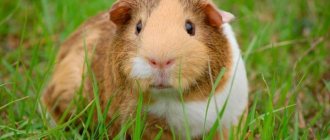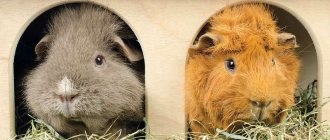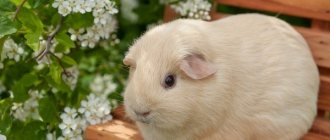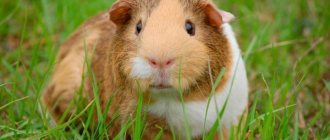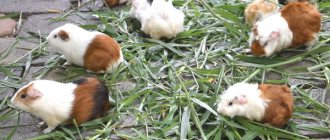- home
- Guinea pig
- Guinea pig health
02/18/2019 Small animals live quite short lives. These include rodents such as guinea pigs. Despite the life expectancy of 6–9 years, various severe injuries and illnesses can significantly reduce it. Therefore, every owner of such a pet should know what to do if a guinea pig dies.
How to tell if your guinea pig is dying
Changes in your pig's behavior indicate that its days are numbered. Signs of aging appear gradually, but an attentive owner will definitely notice them:
- Decrease in vital energy level. When a pig dies, it becomes slow. The animal hardly plays, it is difficult for him to move and rise to the second level. An aging rodent spends most of its time sleeping.
- Untidy appearance. Older guinea pigs have no desire to groom themselves. Their coat looks disheveled and their fur is thinning.
- Cloudy eyes. As many pigs age, they develop an age-related disease called cataracts. The pupils become dull and cloudy. This does not mean at all that the animal is dying right now, but it does mean that it does not have long to live.
- Arthritis. Old guinea pigs have deformed limbs and thickened fingers.
- Weight loss. Aging pets gradually lose weight. Loss of body weight is explained by lack of appetite and disruption of the digestive system.
All these signs indirectly indicate the approaching death of the rodent. The pig may die within a few weeks or days. Gradually her condition will worsen. Closer to death, coordination of movements is disrupted - the animal suddenly falls to one side and falls.
The fact that the animal is dying right now is indicated by:
- lack of activity;
- refusal of food - the pig does not even take his favorite treat;
- labored breathing;
- involuntary defecation and urination;
- lack of reaction to light and noise.
Attention! Animals feel their death approaching. When they are about to die, they usually hide in a secluded place.
Signs of a Dying Pet
If the guinea pig is healthy, nothing bothers it, the food is good, there is water and there is no reason for stress, it will be constantly on the move, actively eat food, its eyes will be shiny, and its behavior will be friendly. Such a pet responds with pleasure to games and is distinguished by cleanliness.
If a guinea pig dies, this can be determined by characteristic signs:
- Dull gaze, cloudy cornea;
- coordination of movements is severely impaired, the animal limps, limps, its movement around the cage is difficult, it often falls to the side for no apparent reason;
- completely or partially refuses food (even if she is offered her favorite treat), stops drinking water;
- instead of the usual active movements, the pig sits for a long time in a hunched state, on its back or on its side;
- rapid breathing, wheezing may be heard;
- the animal stops responding to external stimuli, does not notice the owner, tries to hide in the far corner of its home;
- the animal becomes unclean and stops cleaning its coat;
- hair falls out in large quantities, bald patches appear;
- lumps of unknown origin may be felt under the skin;
- the joints of the limbs and fingers become noticeably thicker.
Even if there are none of the listed symptoms, but it becomes noticeable that the animal sleeps most of the time, you should be wary.
How to create additional comfort for an animal
A dying guinea pig needs even more care than usual. Therefore, it is important to try to brighten up her last days of life. How to help a rodent before death:
- It is better to leave the dying animal in a cage with other guinea pigs if they do not harm it. These animals love to be in company. In isolation, the rodent will be bored.
- A dying guinea pig's heart beats slower and its circulation is impaired, so it gets cold. To help her warm up, you need to put a soft, warm cloth in the cage. It is advisable to place the animal’s home in a warm place and ensure that the bedding always remains dry.
- Shortly before death, the animal is so weak that it can no longer independently approach the feeder and drinker. In the last days of his life, he will have to be given food from a spoon or an insulin syringe. It is advisable to grind the food and mix it with a small amount of water. If your pet doesn't want to eat, you don't need to force it.
- A dying pet is much calmer when it feels the love and care of its owner. You should approach the cage more often and stroke the pig’s head. There is no need to pick her up every time so as not to cause pain.
- Let the animal die in peace. It is advisable to place the cage in a quiet room. The lighting should not be too bright. It is necessary to protect the pig from everything that prevents it from feeling safe.
- If the rodent has a favorite thing or toy, it is better to put it in the cage. It will help you calm down.
Severe stress
If the owner often moves from one place to another, then this is a lot of stress for his four-legged friend. He can get sick simply because living conditions are constantly changing. Temperature changes also have a detrimental effect on health. Severe stress can be compounded if the owner at some point decides to place their pet in the hands of another person. Animals sometimes find it difficult to get used to changed living conditions. If they lived in a cage as a pair, then after the death of a relative, the second individual will be sad and yearn.
Deadly diseases of guinea pigs
One of the reasons why guinea pigs die is serious illnesses that the animal’s body cannot overcome. Most often they are caused by deadly infections.
Enteritis
Infectious enteritis is caused by Escherichia coli. Pathogenic bacteria enter the guinea pig's body through nutrition and multiply very quickly in the digestive tract. Within 2-3 days, the rodent can die from intoxication and dehydration.
Symptoms of enteritis:
- bloating;
- severe bloody diarrhea;
- refusal to eat and drink;
- temperature increase;
- convulsions.
Salmonellosis
The causative agent is Salmonella bacteria. This disease is rare in guinea pigs. Rodents can become infected through contact with sick animals, as well as through eating bone meal or food contaminated with pathogenic flora.
Salmonellosis is almost always fatal. It develops rapidly - from the moment the first symptoms appear until death, 1-2 days pass.
Sick pigs have:
- profuse diarrhea with mucus;
- bloating;
- depression, lethargy;
- hyperthermia;
- The animal does not eat or drink.
Attention! Salmonellosis is dangerous for people. Therefore, after handling a dying guinea pig, you should wash your hands thoroughly. It is advisable to use rubber gloves when cleaning the cage.
Pseudotuberculosis
The causative agents of the disease are pseudotuberculosis bacilli. Infection is possible through contact with sick animals, as well as through contaminated food and water.
This deadly disease has nothing to do with tuberculosis, which affects people. It rarely affects the lungs. Most often, pathogenic bacteria attack the cecum, spleen and liver. When opening a dead pig, white or yellowish nodular formations are found on the internal organs.
Clinical manifestations of the disease:
- exhaustion;
- loss of appetite or complete refusal to eat;
- watery diarrhea, sometimes with bloody inclusions;
- conjunctivitis;
- hyperthermia;
- paralysis of limbs and convulsions.
Pneumonia
Young animals often die from pneumonia due to weaker immunity. A pet can get sick due to hypothermia, exposure to a draft or dampness. Sometimes incompletely cured bronchitis, which can be of either an infectious or non-infectious nature, leads to an inflammatory process in the lungs.
It is important to detect clinical signs of pneumonia as quickly as possible and begin treatment, otherwise your guinea pig will die. These include:
- thirst;
- lethargy;
- nasal discharge;
- sneezing;
- rapid shallow breathing;
- wheezing.
Gymnastics
There are exercises that allow you to train the vestibular apparatus. Perform this complex regularly, and over time you will experience less motion sickness.
Lie on your stomach. Slowly move your head back. Roll over onto your back, slowly tilt your head forward, try to touch your chin to your chest. Repeat the exercise 4-5 times.
Lie on your back. Relax and, without straining your neck muscles, shake your head left and right for 2-3 minutes.
Sitting on a chair, keep your head still, roll your eyes first clockwise (5-6 times), and then counterclockwise the same number of times. Repeat the exercise 2-3 times.
Stand with your feet shoulder-width apart. Slowly tilt your head forward until your chin touches your chest, and then tilt your head back as far as possible. Perform 6–10 times.
While standing, slowly turn your head left and right, 5–10 times in each direction. Make slow circular movements with your head to the right, then to the left. Repeat 4-5 times.
Common non-infectious causes of death
With good care, guinea pigs live 6-8 years. Most rodents have little chance of living to a ripe old age. An animal can die not only due to infection.
The most common causes of death:
- malignant neoplasms on the body;
- falling from height;
- pathological childbirth;
- overheat;
- fear or severe stress;
- entry of a foreign object into the respiratory tract;
- avitaminosis;
- dehydration due to indigestion;
- diseases of the heart, blood vessels, endocrine system;
- poisoning.
Health problems in guinea pigs begin to appear when they reach 5 years of age. Some rodents develop tumors after 3 years, from which the animal dies.
Interesting features of other sensory organs
Hearing
The cochlea of the human ear has only two turns, but these rodents have four. Due to the special structure of the cochlea of the inner ear, guinea pigs have excellent hearing.
Smell
Rodents most often use their sense of smell for contact with each other and during the mating season. Since the animals live in communities, they are able to recognize a stranger by smell.
They specifically mark their territory with urine to help them understand boundaries. In familiar smells, pigs feel calm and confident, but as soon as they find themselves in an unfamiliar environment, they begin to worry and become scared.
If we compare a rodent’s sense of smell with a human’s, we can note that the animal’s sense of smell is a thousand times sharper. They are able to distinguish a huge range of odors that are invisible to the human nose. Therefore, the owner of the animal often does not understand why the baby is worried.
While eating food, pigs use their sense of smell to determine which foods they can eat and which they cannot. The same applies to the people around them: they identify their owner by smell. Animals in any situation first trust their sense of smell, and only then other organs.
Touch
Guinea pigs have tactile hairs around their mouth and nose. They help animals navigate in space and act as a kind of probes.
With their help, animals determine whether there are obstacles in their way, whether there is an opportunity to get into this or that hole.
Taste perception
Sometimes the animal's sense of smell can fail. Then taste receptors come to the rescue. With their help, the animal will determine the quality of the food.
If a rodent has to choose between sweet and salty, it will choose the first. But he can calmly eat bitter food. In general, each individual has its own taste preferences.
Sound perception
What sets guinea pigs apart from other rodents is the wide range of sounds they make. Starting from simple muttering expressing pleasure; cooing, a sound with which they establish interpersonal contacts, ending with the clicking of teeth, with which they notify of an imminent attack for the main role among males.
Guinea pigs have a rich range of sounds that they are capable of making. For example, young individuals squeak piercingly, calling their mother to come to their aid. At the same time, females respond less and less each time to the call of the young. They do this deliberately in order to accustom their children to independent living.
Mature individuals are able to make sounds that express fear. A person can easily recognize them. If animals live in groups, then you can notice that if one individual begins to make a sound of danger, then all the others, one after another, hurry to hide in a shelter.
But guinea pigs sometimes experience stupor during severe fright. The animal freezes and remains motionless for a long time. It is believed that this is a form of self-defense.
Despite the fact that the vision of rodents is not well developed, nature has endowed them with acute hearing, a sensitive sense of smell, and excellent perception of tastes. Thus, with the help of its senses, the animal is able to protect itself from danger, and, if necessary, hide in a safe place.
Euthanasia
If your guinea pig's condition is incompatible with life and your veterinarian has confirmed that it is dying, you may be able to relieve its suffering through euthanasia. As painful as it may be to realize that your beloved pet will be gone forever, sometimes this is the best way to help him.
The procedure can be performed at home. To do this, invite a specialist from a veterinary clinic. The rodent will not feel anything - first the doctor administers a strong anesthesia. After a few minutes, the guinea pig will fall asleep. Only then is a second drug administered, which causes cardiac arrest. Thanks to euthanasia, the rodent dies quickly, without pain and suffering.
The average cost of euthanasia is 1000-1200 rubles.
Attention! The veterinarian will not agree to euthanize the animal if there are insufficient indications for this procedure. You cannot just go to the clinic and ask to take the life of a pet because it is old or causing inconvenience to the owners.
Various infections
Contrary to popular belief, these animals often get sick. The fact is that a person cannot always competently comply with all conditions of detention. For example, if there is also a dog in the apartment, then sometimes it may even turn out that it brings home some kind of infection on its paws. As a result, the rodent becomes infected, but the dog remains healthy. It is almost impossible to prevent such cases. If this happens, it is recommended to immediately take your pet to a veterinary clinic. Treatment will not be cheap, but the pet can be saved. Infections are also dangerous because the course of the disease can be completely asymptomatic for some time.
What to do if your guinea pig dies
When a pig dies, it lies motionless on its side and is not breathing. Eyes may be open or closed. This is a very sad sight. Coming to terms with loss is not easy even for adults, let alone children. It is important to realize what happened and try to accept it, no matter how hard it is.
Some people are afraid to open up their feelings, to show that they are hurt. However, it is normal to feel sad about your guinea pig who has died. The bitterness of loss will gradually dull, but it takes time. To make it easier to bear the death of a pet, you need to give vent to your emotions - cry when you want, share your feelings with friends.
For some people, the pain of loss is helped by fond memories of the deceased guinea pig. Surely every owner has photographs of the animal. It's worth printing out a few and reviewing them periodically. The most beautiful photo can be framed and hung on the wall.
How to survive the death of a beloved dog: advice from a priest
Faced with inevitable grief, many owners have no idea how to cope with the death of their beloved dog. There are various techniques that help relieve acute pain, but the final recovery from loss comes only with time.
Science has established that a person experiences the death of a loved one (including a person) within 1 year. Many owners find it easier to cope with loss if another animal appears in the house.
There are two opposing techniques to help cope with loss:
- Suspension.
- Living with memories until they stop hurting.
This happens due to excessive closeness between the owner and the pet. It often happens to older people whose children live separately and have no one else. Thus, the dog becomes an object of care and care, in a sense, a support for the person. It is thanks to a dog that a person lives, he wants to return home and live for someone.
Why is it very difficult to cope with the death of a dog:
- If the family is large, then despite the huge number of members, strong grief may be felt, as well as the grief of loss. This is also due to excessive stress between the pet and the owner. This especially happens if the dog and the owner are compatible in character; they understand each other very well.
- Many people wonder why people kill animals so much. After all, it’s just a dog, you can get a new one. However, everything is not as simple as it seems. The emotions from the death of an animal are practically no different from those when a loved one dies.
- Exactly the same phases occur that a person faces after death. Depression, apathy, and some inhibition in action may appear. In order to cope with the death of a dog, you need to occupy yourself with something else.
The dog is sick
How to drown out the pain of losing a beloved dog, how to let a dead dog go from your thoughts, advice from a psychologist:
- Remove all things from view, you can give them to friends or simply throw them away. Be sure to tell your friends about your loss. There are people who, just like you, have experienced the death of an animal, so they can calm you down and console you.
- If you have a family, then you need to find something to do, something to do. First of all, you need to start cleaning the house in order to think about your pet as little as possible and drive away such thoughts from yourself. The more you think about your pet, the deeper depression and anxiety sucks you in.
The dog is sick
If a person is lonely, you need to find some kind of hobby, go on a trip, visit, or do things that have been put off for a long time. It could be some boring routine work that is very exhausting. Thus, there is practically no strength left; the person has no time to think about the death of the pet.
How to survive the death of a beloved dog, advice from a priest:
- If you feel that it is very difficult to cope with the bitterness of loss, do not hesitate to contact specialists. This could be a psychotherapist or psychologist. No self-respecting doctor will say that it is just an animal and there is no need to worry. He will provide you with the help you need.
- A clergyman will also help you cope with the loss. Feel free to come to church, light a candle for the dog, peace of mind. Tell the priest about your loss. It will help you deal with mental anguish, calm you down, and perhaps after visiting the temple it will become much easier.
- The clergy call for humility and calm, so you need to try to think less about the dog and fill the void with something. After all, a large amount of free time provokes unnecessary thoughts about the dog.
In most cases, psychologists recommend getting a new dog six months after the death of a pet. Moreover, it is best to take a pet from a shelter or the street. The fact is that these dogs are the most grateful, intelligent and understand the value of living in good conditions. This dog will be grateful to you for the rest of its life.
If one of your friends' dog died, you need to sympathize.
It’s better not to remind the animal about the death at all and just try to distract the person. Invite him to the movies or on vacation.
Sad
There are a lot of reviews from owners who have lost their dogs. They know better than anyone how to cope with the death of a beloved pet.
Dog
Initially, experts recommend preparing yourself for the death of your dog. On average, a dog lives 13-15 years, so you need to be prepared for the fact that you will outlive your pet. Under no circumstances should you be upset. If you have a child, it is recommended to get another dog after the pet turns 8-9 years old.
Antibiotic toxicity
Guinea pigs are extremely sensitive to antibiotic treatment, the inappropriate use of which (wrong dosage, wrong type) can lead to fatal enterotoxemia [5] [8]. Some antibiotics should not be used on guinea pigs, and it is therefore important to take sick guinea pigs to a veterinarian who is familiar with them whenever possible (preferably a board-certified "exotic animal" veterinarian). If you are suffering from antibiotic-related illness, treatment should be stopped immediately and your guinea pig should be given liquid therapy, a syringe of high fiber food and other supportive care.
to swell
GI stasis can lead to excessive gas production, which can cause the stomach and intestines to fill with gas. This gas, produced in small quantities during healthy fermentation, is usually eliminated by bowel movements, but in animals with reduced or congested gastrointestinal movements, it can cause painful distension of the animal's stomach [11] [12]. Sudden death may occur simply because the condition is painful and the guinea pig may go into shock or for other reasons.
Longhair
Unusual and beautiful guinea pigs with long hair come in completely different varieties and have the most unusual names. At first glance, it is very difficult to understand which animal is in front of your eyes: a shaggy dog or a fluffy bunny. These thoroughbred “hippies” appeared thanks to the incredible efforts of breeders. Almost all rodents have thick and long hair, which in some breeds can exceed 45 centimeters.
Sheltie
These guinea pigs are very nice to touch as they are quite soft to the touch. Their fur, unlike other relatives, does not have a parting, but simply falls back. The hair on the head is thicker and somewhat resembles a mane. Like other long-haired animals, Shelties are friendly and calm.
Coronet
These are the most active representatives among all guinea pigs with long hair. Their characteristic feature is a single rosette on the head. The long fur flows on both sides, but does not cover their face.
Alpaca
This beauty has very long and curly fur. It looks a little like sheep's wool. In addition, it grows towards the head. There are 2 rosettes on the sacrum, another one is located on the head, and looks like a bang.
The fur on the face is a little coarser than on the rest of the body. Alpaca guinea pigs are quite compact, with small and neat ears. Their color is very different - from black to golden. In rare cases, you can even find two-color or three-color alpacas.
Texel
This is the most beautiful breed of long-haired guinea pig, and it was the result of crossing two breeds: Sheltie and Royal (Rex). Their curly fur grows from the head. In addition, it cascades across the entire back from the parting, framing the head without long hair. The length of the hairs can reach up to 15 centimeters.
This breed of pigs is a bit like fluffy balls that you want to pick up. They have beautiful big eyes and small ears shaped like rose petals. The color of the texels is quite varied. Among them you can even find white guinea pigs.
Merino
Such guinea pigs are also called royal guinea pigs, and all thanks to their beautiful and curly hair. Their head is decorated with a rosette that resembles a crown. The fur is very long, so owners often have to cut their pets in the summer. Their color can be white or gray, and also combine several shades at the same time.
Peruvian
This breed of pigs has become quite popular due to its docile nature, as well as its beautiful appearance. Their fur is very soft and long, so it requires constant care. There are rosettes on the sacrum and also on the nose. The animal's face is covered with long bangs.
Peruvian guinea pigs can be single or multi-colored, but most often their color is silver-gray. They live no more than 6 years and weigh up to 1.5 kilograms.
Kui
This is the largest breed of guinea pigs, sometimes weighing up to 4 kilograms. Most often they are raised for meat. Cuis are more considered to be smooth-haired breeds of pigs, but among them it is worth noting Peruvian animals that are bred as decorative creatures.
This species reproduces poorly and is also prone to various diseases. In addition, they have a very aggressive character. Almost all kui have 5 or 6 toes on their paws, however, this does not bother them at all. Most of them do not live very long, within 3 years.




